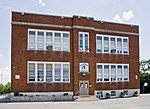Little Conococheague Creek
Maryland river stubsPennsylvania geography stubsPennsylvania river stubsRivers of Fulton County, PennsylvaniaRivers of Maryland ... and 4 more
Rivers of PennsylvaniaRivers of Washington County, MarylandTributaries of the Potomac RiverWashington County, Maryland geography stubs
Little Conococheague Creek is a 12.4-mile-long (20.0 km) tributary stream of the Potomac River in the U.S. states of Maryland and Pennsylvania. The stream rises on Two Top Mountain, west of the Whitetail Ski Resort in Franklin County, Pennsylvania, and proceeds south into Washington County, Maryland. It empties into the Potomac about 2 miles (3 km) southeast of Big Spring, Maryland. The watershed of the creek is 18 square miles (47 km2) and includes Indian Springs Wildlife Management Area. Tributaries include Toms Run.
Excerpt from the Wikipedia article Little Conococheague Creek (License: CC BY-SA 3.0, Authors).Little Conococheague Creek
Chesapeake and Ohio Canal Trail,
Geographical coordinates (GPS) Address Nearby Places Show on map
Geographical coordinates (GPS)
| Latitude | Longitude |
|---|---|
| N 39.603707 ° | E -77.907775 ° |
Address
Chesapeake and Ohio Canal Trail
Chesapeake and Ohio Canal Trail
25419
Maryland, United States
Open on Google Maps








